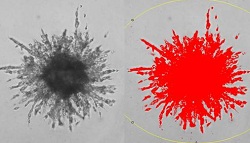AMSBIO says there is a growing need for more complete and physiologically predictive cancer invasion models, and so has launched its new 3D Culture 96-Well BME cell invasion assay to address this.

Amsbio points to growing evidence that spheriod cell cultures provide a more physiologically-relevant model
The BME (basement membrane extract) assay offers a flexible high-throughput format for quantitating the penetration of basement membrane barriers by invasive cells in 3D spheroid cultures, in response to chemo attractants and/or inhibiting compounds.
The company reports growing evidence that tumour cell aggregates (spheroids) provide a better in vivo model of tumours than conventional adherent monolayers.
Spheroids exhibit physiological traits including their morphology, cell-cell bonds, proliferation rates, cell survival, tumour dormancy, and a hypoxic core, which make them a superior analogue.
Accordingly, a 3D culture invasion assay provides a more relevant physiological approach for assessing tumour invasion and provides a visual component that can be quantitated through image analysis, it says.
The new Amsbio BME assay uses a 96-well spheroid plate along with a special spheroid formation matrix to drive aggregation of cells.
The resulting spheroid is embedded in an invasion matrix of basement membrane proteins. This forms a hydrogel network on which invasive cells can travel, and at this point, invasion modulating agents can be applied to evaluate the impact on cell response.
Cell invasion is visualised microscopically and can be quantitated through image analysis software.
